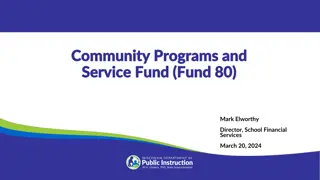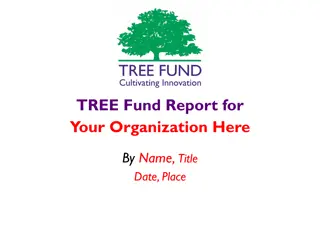Strategies for Building a Successful Endowment Fund
Explore the key steps involved in developing and managing an endowment fund effectively. From understanding the role of endowment and assessing vital statistics to identifying legal and practical definitions, this guide provides essential insights to help organizations make sound decisions for sustainable financial growth.
Download Presentation

Please find below an Image/Link to download the presentation.
The content on the website is provided AS IS for your information and personal use only. It may not be sold, licensed, or shared on other websites without obtaining consent from the author. Download presentation by click this link. If you encounter any issues during the download, it is possible that the publisher has removed the file from their server.
E N D
Presentation Transcript
Five Steps to a Successful Endowment Kathryn W. Miree & Associates, Inc.
What Well Cover We will begin with the role of endowment. Then, we ll go through the process of building an endowment in five steps. Building endowment requires a proactive process. It s easy to get lost without a plan - so the last step is to make a plan and set goals.
How Well Do You Know Your Endowment s Vital Statistics?
Take the Test 1. Does your organization have an endowment? 2. What is the market value of that endowment? 3. What is the current asset allocation of the endowment? 4. How has that asset allocation changed over the last year with the dramatic changes in the markets? 5. What was the total return on your endowment last year? Over the last five years? 6. How do your total returns compare to the blended index? 7. What is the spending policy for the endowment? 4
Take the Test 8. Are there any restrictions on terms a donor an impose on endowment gifts? 9. Are there any restrictions on the type of assets that can be contributed to your endowment? 10. Who makes decisions about distributions from your endowment? 5
Score Your Results Number Answered Scoring 9-10 Your donors will be impressed 5-8 You will survive the conversation 3-4 Prepare to be humbled. 0-2 Do you really work there? 6
An Endowment Overview: The Role of Endowment
Defining Endowment Why is a definition necessary? Each nonprofit has a definition Each board member may have a definition Many organizations have funds scattered in a variety of accounts which are endowment?
The Legal and Practical Definitions Endowment n. the creation of a fund, often by gift or bequest from a dead person s estate, for the maintenance of a public institution, particularly a college, university, or scholarship. ENDOWMENT. The bestowing or assuring of a dower to a woman. It is sometimes used: metaphorically, for the setting a provision for a charitable institution, as the endowment of a hospital.
The Legal and Practical Definitions Endowment: A permanent fund bestowed upon an individual or institution, such as a university, museum, hospital, or foundation, to be used for a specific purpose. Endowments may be separately held funds within the charity, or separately established nonprofits holding long-term funds generally referred to as supporting organizations to the charity. 10 7
My Definition Endowment: Funds set aside for the long-term use of the charity, the principal of which is invested and the earnings of which are used to further the charity s mission.
Forms of Endowment True endowment Quasi endowment Term Endowment Pooled Endowment
The Paradigm Shift Not too many years ago endowments were an embarrassment of riches Now, fiduciary duty However, the urgency of current programs must be balanced with preparing for the future
Why So Much Talk About Creating an Endowment? The economy is tough and taking a toll on donors Fluctuating stock market returns Low interest rates Stalled economy
Why So Much Talk About Creating an Endowment? Key Equity Indexes 2000 2001 2002 2008 2011 2015 DJIA -6.18% -7.1% -16.76% -33.8% 5.5% -2.2% S&P -10.14% -13.09% -23.37% -38.5% 0% -0.7% NASDAQ -39.29% -21.05% -31.53% -40.5% -1.8% 5.7%
Why So Much Talk About Creating an Endowment? The prime rate remained at 3.25% from the first quarter of 2009 through mid-December 2015 (rose to 3.5%) The 7520 rate slipped as low as 1% over this period Low rates dramatically decrease retirement income adding stress to donors
Why So Much Talk About Creating an Endowment? Government grants are disappearing greater needs with less available funds National Association of State budget Officer Fiscal Survey of States Medicaid and education are consuming more and more - pensions and infrastructure are also capturing budget funds Federal government deficit at high
Why So Much Talk About Endowment? Private foundation grants are shrinking The number of charities reaching out to your donors is increasing 1625000 1300000 975000 650000 325000 0 2000 2001 2002 2003 2004 2005 2006 2007 2008 2009 2010 2011 2012 2013 2014
Do You Need Endowment? Does the organization serve a purpose or need that is likely to exist on a long-term basis? Do cyclical economic variances impact the receipt of annual or special event gifts? Does the organization face increasing operating costs?
Do You Need Endowment? Does the organization have new programs related to mission that cannot be operated because they lack funding? Do you anticipate future needs that will require funding? Do you face increasing competition? Are you dependent upon grants? Have you lost gifts because of death?
The Link Between Endowment and Planned Giving Planned gifts, legacy gifts, and endowment are closely tied Annual gifts from income Lasting gifts from assets Continuation of the relationship with the donor
The Fundraising Pyramid Donor Engagement Nonprofit Outreach PLANNED GIVING Transformational MAJOR GIVING Transactional and Transformational ANNUAL GIVING includes Membership Transactional
A Strategic Assessment of the Task Your Strengths: Visibility in the community and a network of donors An opportunity to work with and support each other Knowledge of the needs of your organization and its vision An active fundraising program on which to build. Years of information about your donors.
A Strategic Assessment of the Task Your Weaknesses You may be new to the process of building endowment. You may have limited staff. Further, you may not be trained in the more complex gift transactions that add flexibility and range to donors in making endowment gifts. You may not have the time to build the infrastructure, assemble and manage the volunteer team, and expand the marketing.
A Strategic Assessment Your Opportunities: You re creating a long-term resource. An endowment provides funds to capitalize on opportunities or expand strategically. You ll have resources to respond quickly to critical and urgent needs. You ll have resources to take on new ventures not covered by annual revenue.
A Strategic Assessment of the Task Your challenges: Articulating the case for endowment and integrating that case into your messaging. Finding the time to prioritize endowment and give it the attention it needs. Changing the culture of your organization. Positioning endowment to encourage donors to make annual, capital, and endowed gifts.
Ready to Go? Step One: Create a case for endowment Step Two: Build an infrastructure for endowment Step Three: Build the team to build endowment Step Four: Market the endowment and begin to talk with donors Step Five: Make a plan to create and build endowment and set goals 27
Step One: Making the Case for Endowment
The Case Statement The internal case for support: Start by building the case among staff and board Why do you need endowment? Take the board through the exercise of answering these questions: Do you have a long-term purpose? Do cyclical economic variances impact annual fund? Do you have new programs you want to pursue but no dollars?
The Case Statement The questions, continued: Do you anticipate future needs not currently funded? Is there more competition for annual gifts? Are you dependent on grants? Are you losing donors through mortality, or a move from the community?
The Six Greatest Concerns How can we hold money for the future, when there are so many needs today? We will appear rich. We don t want restrictions on gifts. Won t endowment giving hurt annual giving? These gifts seem complicated. This process costs money.
The Case Statement The external case why donors should give Should inspire vision Should inspire passion Should be urgent Should involve the donor
Step Two: Building an Infrastructure to Support Endowment
The Perfect Profile for Success An organization that has been in existence for at least 8 to 10 years. A history of strong program growth. A growing fundraising program. Stable nonprofit staff. A financial officer with an understanding of and ability to manage endowment. Commitment of the board of directors.
A Survey of Managers: The Most Common Problems Administrative costs that are too large a percentage of revenue Proliferating and scattered funds Managing the paperwork Allocating restricting funds to designated purposes and proving it Funds that outlive their purpose Negative investment returns Litigious donors
The Endowment Structure: Form Type of Entity Pros Cons Segregated account with the charity Low cost Flexible Vulnerable Changing boards Liability Stand alone foundation Protection from liability and spending Separate board High cost to create and operate Under scrutiny Takes time Community Foundation Does everything Visible and credible Not your assets Little input
Other Issues Consolidation Can t manage easily if funds are scattered Must distinguish between true and quasi- endowment Put your hands on endowment documents Designated gifts Need policies: Size Limited purpose Accounting cost
One Solution Students/Fa milies Greatest Needs Teaching Excellence Programs Grounds and Facilities
Allow Gift Options at All Levels Level of Giving Designation of Use Recognition $1 - $49,999 May designate sector Recognized in year of gift $50,000 - $249,999 May designate sector Recognized in year of gift and annually in association with sector $250,000+ May designate sector and purpose Recognized in year of gift and annually
Gift Acceptance Policies Primary benefit is to maintain discipline, while opening doors to additional assets Often come late in a development program as charities move beyond cash and marketable securities There is organizational and board liability for mistakes.
Gift Acceptance Policies Why? Decisions on a case by case scenario are inconsistent. The glittering appeal of the gift obfuscates good judgment. Without policies, you may send mixed signals to donors. Good policies will keep donors from making mistakes. 1. 2. 3. 4.
Spending Policies Spending policy for endowed funds Principle distributions from quasi- endowment
Clear Investment Policies Laws governing investment management Check state law UMIFA - 1972 UPMIFA - 2006 Change in prudence standards standards for investment Change in spending policy requirements - historic dollar value Changing and releasing the use or purpose of fund
Other Considerations Adopt written investment policies that guide asset allocation, restrictions on risky assets, and clear objectives and statements of risk. Articulate your goals for the investment manager. Use a qualified professional manager Monitor the manager. Do not invest in an asset you cannot understand.
The Endowment Agreement The importance of shared expectations Creating flexibility Solving problems with current documents Typical problems Investment restrictions Distribution restrictions Small funds Options in solving problems Document solutions Living donors Statutory solutions Judicial solutions
Accounting and Accountability Reporting to stakeholders Getting the work done Internal management Third party firm for management
Building the Endowment Team Be patient endowments and legacies take time Remember you re working with your best donors Build a well-informed, motivated, inspired team Each individual should understand the role they play in success
The Role of the Board Engage in planning Participate in endowment design Ask questions! Ensure accountability Review regular report on progress Support process in budget Provide support in outreach Adopt policies, including ethics Consider a gift!
The Role of Staff: CEO Drive strategic planning Oversee case statement and Deferred Giving Plan Ensure board is on board Make regular reports to board and staff Recruit planned giving committee Draft resolution to commit gifts to endowment Assign oversight of endowment Create endowment agreements Set goals Prepare gift proposals Report gifts Support calls























